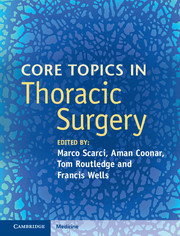Book contents
- Frontmatter
- Contents
- List of contributors
- Section I Diagnostic work-up of the thoracic surgery patient
- Section II Upper airway
- Section III Benign conditions of the lung
- Section IV Malignant conditions of the lung
- Section V Diseases of the pleura
- 18 Tube thoracostomy: evidence-based management of chest drains following pulmonary surgery
- 19 Primary spontaneous pneumothorax
- 20 Bronchopleural fistula management
- Section VI Diseases of the chest wall and diaphragm
- Section VII Disorders of the esophagus
- Section VIII Other topics
- Index
- References
18 - Tube thoracostomy: evidence-based management of chest drains following pulmonary surgery
from Section V - Diseases of the pleura
Published online by Cambridge University Press: 05 September 2016
- Frontmatter
- Contents
- List of contributors
- Section I Diagnostic work-up of the thoracic surgery patient
- Section II Upper airway
- Section III Benign conditions of the lung
- Section IV Malignant conditions of the lung
- Section V Diseases of the pleura
- 18 Tube thoracostomy: evidence-based management of chest drains following pulmonary surgery
- 19 Primary spontaneous pneumothorax
- 20 Bronchopleural fistula management
- Section VI Diseases of the chest wall and diaphragm
- Section VII Disorders of the esophagus
- Section VIII Other topics
- Index
- References
Summary
Management of chest tubes remains a critical aspect in the post-operative course of patients following lung resection. It is traditionally influenced by two factors: presence of air leak and daily pleural fluid output. The combination of these two factors has characterized protocols of chest tube removal.
Prolonged air leak
Figures from the last edition of the European Society of Thoracic Surgeons Database Annual Report (www.ests.org/documents/PDF/Database_ESTS_Report_2012.pdf) showed that the incidence of an air leak lasting longer than 5 days is about 8.3% after lobectomy, 6.8% after segmentectomy and 3.5% after wedge resection.
These data confirm that prolonged air leak (PAL) remains a bothersome complication. Several authors have shown that PAL is a major determinant of post-operative hospital stay and costs. Varela and colleagues have shown that only 10% of patients with PAL are likely to be discharged by the seventh post-operative day, whereas 90% of those without PAL can be sent home by this time. They found that the excess cost attributable to PAL (driven mainly by the increased length of stay) was about 39,000 euros in 21 patients with this complication, an average of 1,860 euros per patient.
Although many patients can be safely sent home with a one-way valve or portable chest drainage system, this practice is not always well accepted by patients, is not feasible in all settings and is not possible for patients with medium- to high-grade air leaks.
PAL is not only a financial issue, but it has also been shown to increase the risk of other medical complications, particularly empyema.
For this reason, several authors have attempted to predict the occurrence of this complication in an effort to identify high-risk patients in whom to apply preventative measures.
The most consistently reported risk factors are reduced pulmonary function indicative of a damaged and fragile lung parenchyma, use of steroids, performance of an upper lobectomy, low body-mass index (BMI) and presence of pleural adhesions. Together with the group from Salamanca, we recently developed an aggregate risk model stratifying the risk of PAL in four risk classes according to the presence of four weighted factors: age > 65, 1 point; presence of adhesions, 1 point; FEV1 < 80%, 1.5 points; and body-mass index < 25.5, 2 points.
- Type
- Chapter
- Information
- Core Topics in Thoracic Surgery , pp. 179 - 187Publisher: Cambridge University PressPrint publication year: 2016



